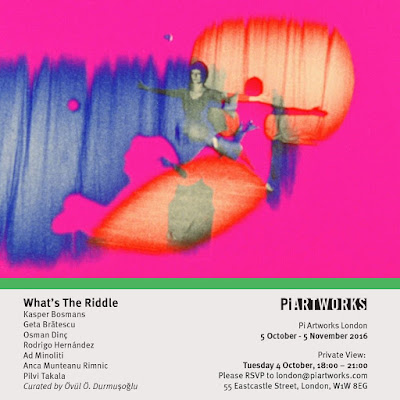What’s The Riddle
What’s The Riddle
5 October – 5 November
Private View: Tuesday 4 October 18:00-20:30
Pi Artworks London is pleased to announce What’s The Riddle curated by Berlin-based curator Övül Ö. Durmusoglu. What’s The Riddle is the first of five exhibitions that make up Pi Artworks London’s Curatorial Season that runs from October 2016 – July 2017. For the season Övül Ö. Durmusoglu, Alexandra Schwartz, Sacha Craddock, Oliver Sumner, and Morgan Quaintance have been invited to devise and develop their own curatorial project working with artists predominantly or entirely from outside the gallery’s roster.
Our personal and political environments are shaped and sometimes traumatised by the choices we are asked to make; like or dislike, yes or no, in or out. They offer no solutions to widespread discontent. Perhaps if the answers cannot suffice, then it’s time to reformulate the questions. A parallel reality where things are organically more complex and diverse requires the artistic ability to critique, to imagine beyond the perceived knowledge, and to shift the collective memory. What’s The Riddle brings together artworks that return to fundamental formal questions of artistic work and its system in their alternative conception of time. Kasper Bosmans, Geta Brătescu, Osman Dinç, Rodrigo Hernández, Ad Minoliti, Anca Munteanu Rimnic, and Pilvi Takala search for the riddle, challenge the drive to seek correct answers, and reconfigure their mythologies.
Osman Dinç looks at the essential, earthly knowledge with artistic questions that are plain, direct and poetic. Choreographing elements like metal, glass, and earth together, Dinç is obsessed with working towards new formulations that address essential earthly knowledge. All his artistic life he has worked in series intertwined with each other in an attempt to stop time. Kasper Bosmans works with curiosities, puzzles, riddles and surprises. He gathers material incessantly, collecting it in notebooks and drawings. His drawings Legend Sint Rombout + Vitiligo [2016] are part of the process of making legends to map out his intuitive thinking where idiosyncratic daily impressions enjoy a playful dialogue with universal, ancestral symbology in the way they appear. In Anca Munteanu Rimnic’s newly conjured photographic triptych the artist speaks of a mesmeric possibility between what was, what is and what if'. Her poetic dialogue with the psychoanalytic computer program Eliza from the 1960s tickles her reader with humour, showing what is lost in the interaction between a machine and a human.
Rodrigo Hernández’s anachronistic narratives are composed of fragments of stories, dreams, and visions. He invites his audience into a playful dialogue with these narratives, to be part of a flowing thread of well-learned questions and images they had forgotten over time. Hernandez works with how we perceive and how we make what is perceived our own. In a time of self-affirmations, he prefers to dissipate essences and their mythologies by edging the spheres of our imagination with a dose of very needed ambiguity. The idea behind Pilvi Takala’s Workers Forum [2016] came from her experience working for a service in the United States where users pay for a pretend girlfriend or boyfriend to text them. Takala was fascinated by the potential in the fictional space created in the text message exchange, but like many of the other workers, she was frustrated by the inconsistencies and lack of quality in the existing service. Making Workers Forum she observed that human relationships cannot work without their fictions such as the one provided by the luminescent beep and the machine seems not to function properly without its precarious human prosthesis.
Geta Brătescu video work The Line [2014], made in collaboration with Stefan Sava, came out of her multifaceted thinking on drawing. The camera focuses on her hands as she sketches in her drawing book, the viewer witnessing moments of self-inquiry, discovery, and deviation. The lines make up timeless, abstract and, dynamic forms that Bratescu has worked with all her life. Ad Minoliti creates extensive multimedia spaces in her paintings and sculptures inspired by cyborgs, geometry and abstraction, genderless identities, a sci-fi inspired queer feminist vision, and vintage pornographic magazines. Her humorous personal utopias take place in these spaces shifting the memory of modernist utopias and proposes imaginative ways to transgress our algorithmically fed perception.
Pi Artworks London is open Tuesday – Friday, 10:00 – 18:00 and Saturdays, 11:00 – 18:00. For information, interviews and images, please contact Neil Jefferies: nj@piartworks.com / +44 207 637 8403
facebook.com/events/1087524901367902/#
